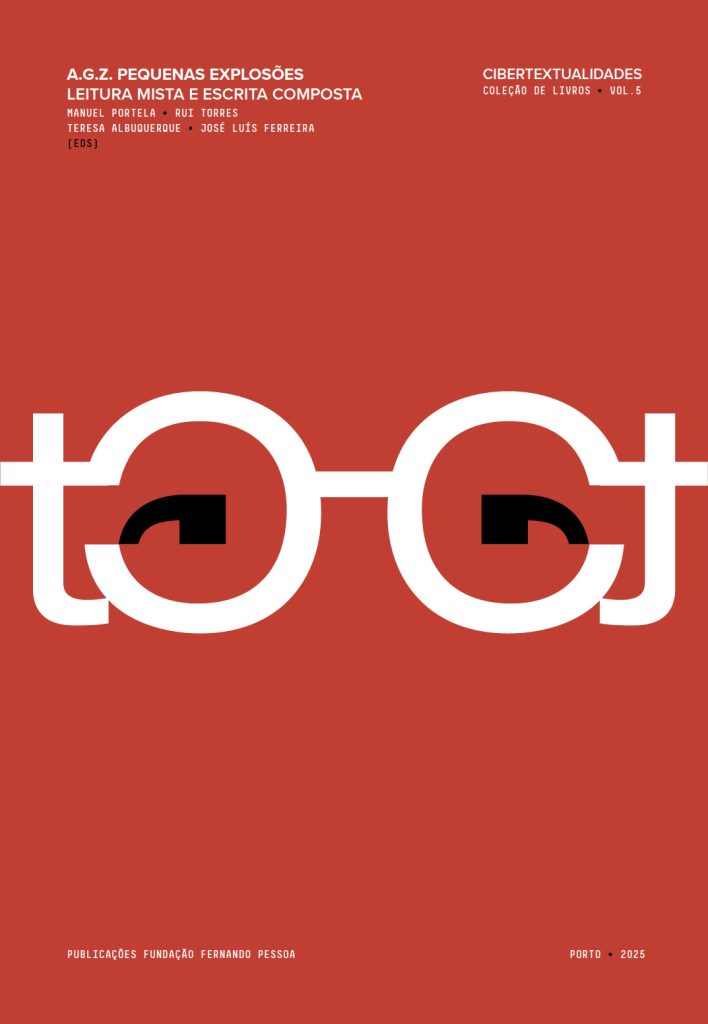A.G.Z. small explosions

Manuel Portela, Rui Torres, Teresa Albuquerque, and José Luís Ferreira, eds. (2025), A.G.Z. pequenas explosões: leitura mista e escrita composta [A.G.Z. small explosions: reading mix and writing jam], Porto: Publicações Fundação Fernando Pessoa.ISBN 978-989-643-193-8. ISSN: 1646-4435. This book (volume 5) of the “Cibertextualidades” series is available free of charge as an eBook, published on the Publicações Fundação Fernando Pessoa Institutional Repository: http://hdl.handle.net/10284/14385
This volume brings together the results of the collective writing and reading experience based on the work of Alvaro García de Zúñiga (1958-2014), originally presented on October 31, 2024, at the Faculty of Arts and Humanities at the University of Coimbra. The work is divided into six sections: “Before the explosion”, texts by Teresa Albuquerque, José Luís Ferreira and Pedro Braga Falcão; “Exploding the book”, texts by Alvaro García de Zúñiga, Rui Silva and Ana Sabino; “Exploding the language”, texts by Alvaro García de Zúñiga, Diogo Marques and Ana Marques; “Exploding writing”, texts by Alvaro García de Zúñiga, Patrícia Reina and Bruno Ministro; “Exploding the form”, texts by Alvaro García de Zúñiga, Rui Torres and Sandra Guerreiro Dias; and “A.G.Z. mix & jam”, texts by Alvaro García de Zúñiga, translated and edited by Manuel Portela.
The creative process that originated this game with A.G.Z.’s work is described in the introduction to the volume as follows:
Reading mix and writing jam proposes meaning production operations that are distinct from dominant interpretative practices, which generally consist of reading about texts in order to write about them. This analytical and hermeneutic practice—which I refer to as writing about writing—results in both the objectification that distances the interpreting text from the interpreted text and the premise that the language that interprets a text is not to be confused with the language of the text. Their nature would be immiscible, and the function of writing about writing would be to reinforce the identity and boundaries that distinguish one writing from another. This model of meaning production assumes that the exercise of analysis and interpretation must occur through a metalanguage that conceptually reframes the text to be read within a framework of references and relationships between that text and itself and other texts.
However, it is possible to consider a different relationship between reading and writing. For example: what happens if we read a text as a certain articulation of discursive possibilities and imagine that these possibilities contain other possibilities? In this case, a text would not simply be the instantiation of a self-enclosed formal-semantic unit, but rather a tool for exploring the sayability instantiated in the text itself. The “reading mix and writing jam” creative operation is based precisely on the assumption that it is also possible to write with rather than to write about. And not just on the notion that this with means writing with a previous text. It also stems from the idea that it is possible to write with other writers, that is, writing can be decoupled from an individual enunciative singularity. The two notions seem to be linked: if I transform a text into an instrument or a writing program, the singularity of the voices instantiated within the text is less important than their blending within the field of language that opens up before readers and writers. Writing can be experienced as the collective continuation of a text’s potentiality.
Manuel Portela
